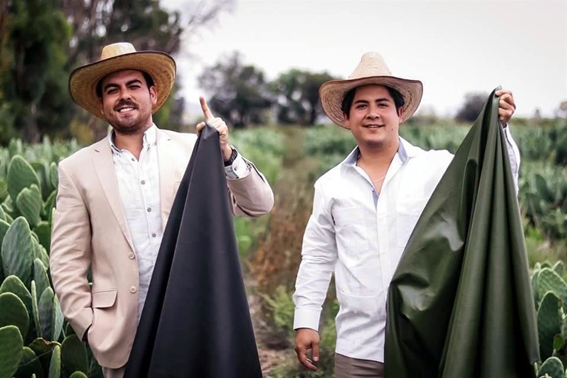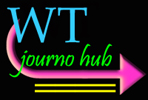|
|
|
|
Features Update 2022/8/4 Blue-green algae Mexican Start-up Adriano Di Marti Disrupts The Leather IndustryNatural organic leather offers a sustainable, cruelty-free alternative, with low water consumption, no toxic chemicals, phthalates, and no PVCBy Suzanne Forcese “It goes without saying that we are not the favorite company for the tanning industry for obvious reasons, but sustainability has never been a luxury, it’s a responsibility for us all.”--Adrian Lopez Velarde, Director/Co-Founder of Adriano Di Marti, Desserto™ and Deserttex™ 
Marte Arturo Cazaras Duarte and Adrian Lopez Velarde holding the sustainable vegan leather materials made from cactus used in a wide range of fashion, furniture and automotive applications under the trademarks Desserto and Deserttex. Nature’s Miracle Born from the need to safeguard the future of the planet and the desire to utilize renewable assets Adriano di Marti Co-Founders Marte Arturo Cazares Duarte and Adrian Lopez Velarde have successfully developed materials under the trademarks Desserto and Deserttex as an alternative to animal leather. The answer to their call to action revealed itself in the Nopal Cactus. The vegan leather material Desserto™ (now being used in the fashion industry) and Deserttex™(used in the automotive industry) offer high resistance to abrasion, rubbing, tearing, tensile and durability thanks to its strong molecular bonding which the cactus offers. WATERTODAY learned more from Adrian Lopez Velarde. The Journey WT: Please tell us about your background and what lead you to develop Desserto® and Deserttex®. Velarde: Marte and I used to work in the fashion and automotive industries where we are familiar with the use of leather. We became conscious that besides the large waste of materials during production processes due to the irregular forms, shapes and surfaces of animal hide, the environmental footprint for obtaining leather was way larger than most of us would realize. Nowadays, climate change is one of the biggest challenges that humanity has to face. In the future, prolonged droughts and desertification are the subjects (among others) that will address several countries where farmers and small producers of low income will become seriously affected. WT: Why have you chosen Cactus to create a revolution in the fashion, furniture and automotive industries? Velarde: Before Desserto® there was no plant-based alternative to leather made in Mexico, and we saw an opportunity to contribute to the industry by devolving our own. We were immediately inspired by Cacti (nopal: Opuntia Ficus Indica) because of its unique characteristics, which provide it with resilience towards the limiting conditions previously mentioned. The nopal is capable of growing on land where other crops won’t prosper. It can be used for the restoration of degraded land. It is the only crop which we can trust. We believe that this plant by its own right should be among the miracles of Nature. Cactus is a natural carbon sink. From our 14 acres, we are able to absorb 8,100 tons of CO2/year while at the farm we only generate 15.3 tons of CO2 annually. The increase of nopal plantations can be a strategy to relieve the accumulation of CO2 in the atmosphere. Nopal can be used as water and carbon reserves on arid and semi-arid regions where climate is erratic. The Problem WT: How has consumer demand of animal leather contributed to deforestation? Velarde: Cattle ranching is the largest driver of Amazon deforestation. About 450,000 sq km of Brazil rainforest is now pasture. For comparison Germany is 35,000 sq km, the UK is 240,000 sq km. 20% of the Amazon has been destroyed and an area the size of the UK is lost every year. WT:How does the world’s demand for animal leather affect our water? Velarde: Most of the world’s leather comes from a cow and that cow has to drink a lot of water. Up to 1800 gallons/year/cow. A third of a million tons of fish are caught each year for cattle feed. One third of all crop land is required for animal feed. Then the leather has to be tanned which requires even more water and it’s treated with toxic chemicals which hurt the environment. This contributes to the 100,000,000 tons of waste that the fashion industry creates. It is argued that environmentally, the tanning industry is simply converting a product that would otherwise go to landfill. From an environmental view (not vegan) this argument is valid were it not for the tremendous environmental harm the tanning industry causes worldwide. Chromium –tanned leather is the most popular form of producing leather these days and one of the most noxious. It relies on a toxic slush of Chromium salts and tannin liquor. Tanning one ton of hide typically results in 20 to 80 cubic meters of water with Chromium concentrations around 250mg/L and Sulphide concentrations at roughly 500mg/L. 70% of an untreated hide is eventually discarded as solid waste – the hair, fat, meat, sinew – all goes to landfill. Wastewater pollution is primarily a by-product of the initial preparation stage, wherein bits of flesh, mold, excrement, and other animal by products are mixed with wash water and discharged with very little or no regulations at all for most cases. For example, Kanpur, India – the self-proclaimed “leather city of the world” once housed more than 10,000 tanneries which, in 2003 were dumping more than 22 tons of effluence into the Ganges River every day. The Solution WT: Please tell us about your operation and the process/ technology you use to create leather made from cactus. Velarde: Here in Mexico, in the state of Zacatecas, we have a ranch where we grow our raw material: cactus. At the ranch we select and cut only the mature leaves of the plant without damaging the cactus itself. So, every 6-8 months we will have a new harvest. Also, we do not use an irrigation system. The cactus grows with rainwater and the earth minerals which are rich in Zacatecas are great for the variety of cactus that we plant. The selected cactus is very resilient and strong. It can handle low temperatures during winter without dying and its thorns are very small so it’s easier and safer for our agriculture team to harvest. The cactus plantation is perennial, meaning that we only plant one time and the plantation lasts for about 8 years. The cactus species we cultivate is native and typical of the region. It is CAM (Crassulacean Acid Metabolism) plant. Its metabolism protects water and doesn’t operate during daytime generating chlorophyll as most plants do. Cactus absorbs CO2 during the night. At that time, the environment is fresh and the plant opens its stoma capturing CO2, generating oxygen and absorbing water present in the atmosphere which normally comes from the morning dew. C3 plants have a chlorophyll metabolism. These C3 plants need on average 1,000 liters of water to produce 1 kilogram of dry matter while cactus (CAM) only needs 200 liters. However, these 200 liters are absorbed by the plant itself through its natural hydroscopic mechanism. At the farm, we do not cut down any of the existing trees. In fact, it’s quite the opposite. As we plant a native cactus from the region the plantations match biodiversity and blend with the wild flora. Since we are fully organic, there is no harm to the biodiversity. Also, our natural techniques stimulate the micro-flora and micro-fauna in the ground which is maintained without damage. Wild fauna like hawks find a favorable environment with nourishment. Within the ranch, after cutting the mature leaves, we dry them under the sun for three days until achieving the exact humidity levels that we seek. So, there is no additional energy used in this drying process. Then we process the organic raw material to make it part of our patented formula which consists of cacti proteins and fibers which are turned into a liquid bio-resin colored by organic pigments. This liquid compound is coated on a carrier which consists of a textile that combined with or without a textile allows us to make Desserto leather. The ranch is fully organic, so there are no herbicides nor pesticides used. All the remaining organic cactus material not used in our process is exported and sold nationally in the food industry. The Leather WT: Where is your leather being used? In what ways is it superior to animal leather. Velarde: Desserto is currently being used for fashion applications from handbags to footwear, to accessories furniture and even luxury packaging. Deserttex is the automotive interior variant. Desserto is plant-based material often distinguished by its great softness of touch while offering a great performance for a wide variety of applications and complying with the most rigorous quality and environmental standards. The aim is to offer cruelty-free, sustainable alternative, without any toxic chemicals, phthalates and PVC. Desserto’s cactus material is partially biodegradable and has technical specifications required by the fashion, leather goods, luxury packaging and furniture industries. Deserttex’s automobile exclusive material provides premium brands a highly sustainable cactus-based material which performs to the standards of the industry. Deserttex is often distinguished by its great softness to the touch. Not only does it handle really well but the level of break in the material is excellent. It also has a degree of roundness and spring which you would normally only find in leather where the collagen acts this way. Recognition WT: You have received an impressive list of awards including: Material ConneXion 2020 in New York; Green Product Award 2020 in Germany; Monte Carlo Fashion Week 2020 in Monaco; Good Design Award Gold Accolade at Fashion Impact 2020 in Australia; Second finalist for the LMVH Innovation Award in France; Innovation Award presented by Samsung Design Icons 2020, Architectural Digest Mexico and Latin America: PETA Compassionate Business Award 2021; PETA Vegan Homeware Awards 2021. What has this meant to you? Has this resulted in any collaborations? Velarde: Earning this number of recognitions and awards in just 3 years, for us is an honor and a responsibility to keep innovating and dabbling into the industry for change. We have established a number of collaborations with several brands that include names like Givenchy, Karl Lagerfeld, Adidas, H&M, Fossil, BMW, Mercedes-Benz and many others. For us it’s motivating to see how brands start to shift from leather to plant-based materials, and having them opt to use our innovation is the most rewarding feeling It doesn’t go without saying we are not the favorite company for the tanning industry for obvious reasons, but sustainability has never been a luxury, it’s a responsibility for us all Moving Forward WT: What’s next for the start-up Adriano Di Marti and your brands Desserto™ and Deserttex™? Velarde: In November 2021, Michael-Kors invested in our company to boost our firm potential and expansion. This year for us has been about reducing our carbon footprint from transportation. Therefore, we have recently inaugurated our European branch office in Milan, Italy, and established a second production unit there. By regionalizing our operations, we will be capable of not only bringing our materials to our customers in a much more efficient and cost-effective way, but also significantly reducing the environmental impact from transportation. WT: Please leave our viewers with one last fashion statement. Velarde: Looking and feeling good wearing leather need not involve animal skins and harm to our environment. Make your own statement by opting for plant-based alternatives and ask for sustainable labels. |
|
All rights reserved 2024 - WTNY - This material may not be reproduced in whole or in part and may not be distributed, publicly performed, proxy cached or otherwise used, except with express permission. |

